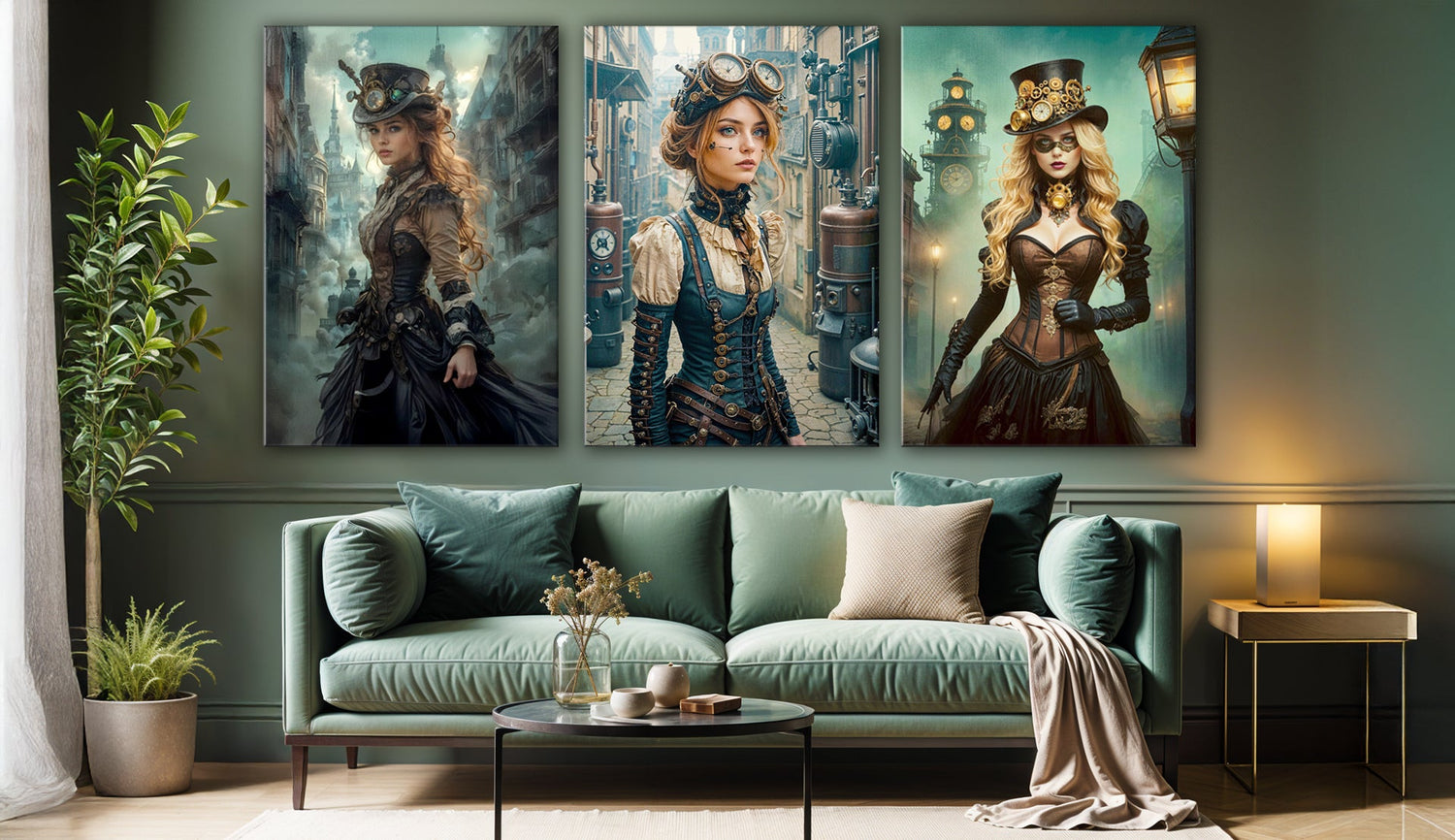
A Symphony in Brass and Flame: Three Steampunk Canvases in Conversation
There are walls that seem to wait, almost impatiently, for something more than paint. You know the feeling: the sofa is in place, the lamps cast their glow, and yet the room feels unfinished, as if it lacks its own voice. Art can supply that voice, though not every artwork speaks in the same way. Some whisper, some shout. And some, when placed together, form a chorus.
The trio of Mistress of Time and Fire, the Clockwork Engineer, and the Steampunk Sentinel has that rare quality of creating dialogue across a wall. Each canvas belongs firmly to the world of steampunk, but they don’t repeat one another. Instead, they play distinct roles: one elemental and commanding, another inventive and methodical, and the last vigilant and martial. Hung as a group, they generate rhythm, a sense of narrative motion that single canvases rarely achieve.
Why three prints often feel more alive than one
Interior designers often speak of the power of odd numbers. One piece can dominate; two can feel balanced but static. Three, however, introduces tension and flow. It makes the eye travel. With canvas wall art, that movement can reshape how a room feels: the gaze lands on one image, lingers, and then is nudged toward another, almost like following a story in chapters.
In this set, the Mistress of Time and Fire commands immediate attention. She stands against a backdrop that swirls with flame and smoke, her uniform ornamented with gears and medals that gleam like embers. The Clockwork Engineer, by contrast, lives in the narrow streets of an imagined city, her attire layered with buckles and brass, her expression somewhere between resolve and curiosity. Finally, the Sentinel appears on the rooftops, weapon in hand, with the looming machinery of a futuristic skyline behind her. Together, they suggest not repetition but progression: energy, invention, and defense.
Of course, one might ask if three such bold wall prints risk overwhelming a space. In a minimalist interior, that concern is valid. Yet with the right placement, the shared motifs—gears, brass tones, and Victorian tailoring—create continuity rather than chaos.
Steampunk’s uneasy place in design
It’s fair to admit that steampunk decor divides opinion. Some view it as over-the-top, more about costume than content. Gears for gears’ sake, corsets without context. Critics aren’t wrong to note that, in weaker examples, the style leans toward parody.
These prints, though, take a different route. They seem to use costume as extension rather than disguise. The Mistress embodies elemental power without tipping into caricature. The Engineer’s intricate harnesses and devices suggest purpose, not just embellishment. And the Sentinel, with her stern gaze and industrial skyline, looks less like a model in costume and more like a character who belongs to her setting.
Printed on canvas, the effect gains another layer. Unlike glossy posters, which can flatten detail, canvas absorbs light. Shadows deepen, brass tones glow rather than glare, and the textures of fabric and machinery feel more tangible. The result is art that shifts with daylight, sometimes muted, sometimes commanding—never frozen.
Creative arrangements beyond the line
The most common instinct with three artworks is to hang them in a straight row. It’s tidy, but it can also feel predictable. These canvases, dramatic as they are, lend themselves to more inventive arrangements.
A triangular cluster, with two side by side and one above, turns the set into something almost heraldic—like an emblem on the wall. A vertical arrangement could suit narrow walls. The Mistress could crown the sequence, and the Sentinel could ground it. A staggered placement, with the canvases offset from one another, would echo the irregularity of steampunk skylines full of towers, pipes, and unbalanced grandeur.

Such layouts do more than just display art. They alter how the room itself is perceived, adding rhythm to static architecture.
A small imagined scene
Picture someone who has just moved into a modern apartment. The furniture is simple: a pale sofa, a glass coffee table, and neat shelving. Clean, yes, but lacking warmth. They decide on this trio of steampunk wall art almost impulsively, intrigued by its drama. Hung above the sofa in a staggered formation, the prints change the room instantly.
When friends visit, they don’t compliment the furniture or the light fixtures—they pause at the wall. “It feels like your place has a story now,” one says. That observation, casual as it is, reveals the true advantage of choosing a set of artworks rather than a single piece. It isn’t about filling space; it’s about creating atmosphere.
Where these canvases belong
Living rooms often benefit most from art that can carry conversation, and these canvases certainly can. Yet they would not be out of place in a bedroom, where their drama might add intimacy, or in a home office, where they could act as imaginative counterweights to routine.
As gifts, they may surprise. Not everyone identifies as a steampunk devotee, yet the combination of vintage tailoring and futuristic machinery can appeal to those who enjoy vintage wall art or even modern wall art with cinematic flair. Their richness makes them flexible: not only for enthusiasts of the genre, but also for anyone seeking to turn a room from plain to atmospheric.
Closing reflection
When art is grouped in threes, it seldom behaves as mere ornament. It introduces rhythm, tension, and the possibility of narrative. The Mistress of Time and Fire, the Clockwork Engineer, and the Steampunk Sentinel exemplify this. They do not simply hang; they converse. They give walls tone and spaces mood.
And perhaps that is what great canvas prints can offer: not just color or subject, but a suggestion of story. The question is less whether a room needs art and more whether it deserves to feel alive.
Discover the Steampunk Canvas Wall Art Collection







